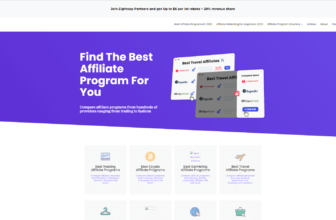
How To Do Affiliate Marketing Without Social Media
Affiliate marketing thrives beyond social media’s bustling platforms. Diverse channels await those who seek alternative paths to success.
In an evolving digital landscape, traditional methods intertwine with innovative strategies to form a robust marketing fabric. This union paves the way for affiliate marketing’s continued relevance.
Crafting a successful affiliate campaign without social media requires astute program selection and a keen understanding of one’s audience, ensuring targeted and effective outreach. Whether you’re in a B2B affiliate program or a gaming affiliate program like betsson affiliates, or perhaps you’re a part of multiple programs; a good strategy is beneficial across the board.
The reason we mention betssson affiliates is that they’re a fantastic program for anyone looking to start gambling or Sportsbet affiliate promote. They have a fantastic commission of 40% and are known to payout on time.
Affiliate Marketing Beyond Social Platforms
Expanding one’s affiliate marketing efforts beyond the ever-evolving realm of social media necessitates a strategic approach that embraces alternative digital and traditional mediums.
This shift involves harnessing the power of content marketing – such as blogging, SEO, and email newsletters – which can drive targeted traffic to affiliate offers without the need for a social media presence. To effectively bypass social media channels yet achieve affiliate success, you have to be tactical.
Leveraging search engine marketing (SEM), participating in niche forums, and utilising direct partnerships can attract the right demographic to your affiliate products.
By concentrating on these channels, one can tailor their marketing efforts to a specific audience, thus increasing conversion rates in a more controlled and refined manner.
Leveraging SEO for Sustainable Traffic
To circumvent social media, SEO becomes an indispensable ally. By optimising content for search engines, you draw organic, relevant traffic directly to your affiliate offers.
Deploying quality content strategically, peppered with researched keywords, acts as a beacon through the digital noise. It ensures prominence on search engine results pages, capturing intent-driven visitors.
Effective SEO transforms websites into customer magnets, pulling in traffic that is both willing and ready to engage.
Consistency in SEO practices is key; it requires regular content updates and staying abreast with algorithm changes. This diligence fosters a trustworthy site that gradually ascends the search rankings, yielding sustained affiliate engagements.
Crafting Compelling Affiliate Content
To excel in affiliate marketing, crafting content that resonates with your target audience is incredibly important. It should provide tangible value, addressing needs or solving problems they may encounter.
Within your content ecosystem, each component must serve a strategic purpose. Whether it is an in-depth review, an informative blog post, or a How-To guide, ensuring the content is meticulously researched and delivers solutions will foster trust and reliability in your brand.
This connection empowers readers to make informed purchasing decisions, thereby increasing the potential for successful affiliate conversions.
Furthermore, authenticity must permeate your affiliate content. As a restaurateur or bar owner looking at side hustles, you understand the power of genuine customer relationships.
Apply this principle to your content, maintaining a tone that reflects your expertise while being relatable to your readers, and watch your affiliate links thrive without the need for social media.
Lastly, a multifaceted approach to content creation will increase engagement. Diverse formats such as videos, podcasts, and downloadable whitepapers can complement written content, providing a rich and varied journey for your audience.
By crafting content that engages, educates, and excites, one establishes a robust foundation for affiliate marketing success, even in the absence of social media platforms.
Mastering Email Marketing Finesse
Email marketing remains a cornerstone in the realm of digital promotion, deftly bypassing the whims of social media trends.
By 2020, statistics from DataReportal revealed a staggering 4 billion daily email users—contextualising the immense potential for an audience this medium holds.
This indicates a captive audience ripe for affiliate marketing strategies, one that’s potentially more stable and receptive than that of transient social media platforms.
Leveraging this channel, however, requires sophisticated segmentation strategies, ensuring that the content of your emails resounds with the precise needs and interests of different audience subsets.
Through careful analysis of customer data, email marketing campaigns can be tailored to heighten relevance and engagement.
Investing in high-quality content will also elevate your email campaigns above mere advertising blasts. This involves crafting newsletters that offer value, whether through insightful articles, exclusive deals, or personal stories that resonate with your subscribers.
Such content encourages higher open rates and engagement, which ultimately may lead to more successful affiliate referrals.
Remember, responsiveness to analytics is crucial for refining your email strategy. Regularly examining open rates, click-through rates, and conversion metrics allows for agile adjustments and maximises the effectiveness of each campaign, strengthening your affiliate marketing efforts without social media reliance.
Unveiling Effective Alternative Channels
Search Engine Optimisation (SEO) provides a robust foundation for organic discovery. High-ranking content draws prospects in, bypassing social media’s transient attention.
Engaging in collaborative content marketing, such as guest blogging on high-authority platforms, can significantly expand your reach. It constructs bridges between your brand and diverse, yet relevant, audiences outside social media spheres.
Leveraging affiliate partnerships with influencers and thought leaders can amplify promotion. Their trusted endorsements transcend the need for a social media presence.
Harnessing the Power of Blogging
Blogs are, without doubt, a potent instrument for affiliate marketers seeking traction outside the confines of social media. They offer a distinct space to cultivate authority and exhibit expertise in chosen niches.
In-depth, high-quality content serves as a magnet for targeted audiences, who may be searching for solutions or insights that your affiliate products offer.
By utilising strategic keywords and SEO practices, your blog can become a traffic-generating engine, organically attracting visitors who are more likely to engage with your content and, ultimately, affiliate links.
Frequent posting and updating content not only improves SEO rankings but also helps to establish a loyal following. Readers tend to return to blogs where they find value, creating multiple touchpoints that facilitate affiliate product promotion without the volatility of social media algorithms.
Lastly, an insightful blog can foster strategic partnerships and backlink opportunities. Connecting with other domain authorities can elevate your site’s visibility and credibility, serving as a conduit for new streams of users predisposed to the types of offerings you promote.
Networking with peers and leveraging guest post exchanges are instrumental for widening your affiliate marketing horizon beyond the social media landscape.
Capitalising on Video Platforms
Video platforms offer significant opportunities for affiliate marketing strategies. One can leverage these platforms to exhibit products and expert reviews or tutorials, which can entice viewers and drive traffic toward affiliate links without necessitating direct interaction on social media channels.
Establishing a presence on video platforms, such as YouTube, allows affiliate marketers to create content with a potentially evergreen lifecycle.
Videos can accrue views over time, and if optimised properly for search engines, they can continue to draw in new viewers, thereby increasing the longevity and effectiveness of affiliate marketing campaigns.
Content creators must be adept at incorporating clear calls to action within their videos. This approach effectively guides viewers toward affiliate products or services.
Furthermore, deploying analytics to understand viewer preferences and behaviours can yield insights to refine and tailor content, enhancing audience retention and conversion rates.
Partnering with established content creators on video platforms can expand reach. Influencers or YouTubers with substantial followings can introduce your affiliated products to a broader audience, sometimes within niche markets that align closely with the product’s intended consumer base, thereby driving more targeted engagement.
Considering video platforms as a primary tool underscores the reality that affiliate marketing extends beyond the domain of social media. With strategic content creation, you’ll be able to foster a dedicated viewership that can be seamlessly transitioned into a reliable consumer segment for your affiliate products.
In the example above, we see an affiliate marketer using YouTube to introduce affiliated products to their audience.
Curating the Ideal Affiliate Portfolio
To embark on a profitable affiliate journey, a strategic selection of programs is imperative. Carefully assess each potential affiliate offering’s relevance to your content theme, audience’s interests, and market demand.
In this process, consideration of commission structures and brand reputation should be at the forefront of your decision-making. Prioritising high-quality products with competitive payouts will ensure a sustainable affiliate model, one that empowers both
Evaluating Affiliate Programmes
Selecting the right affiliate programme is crucial for maximising earnings without relying on social media.
- Commission Structure: Opt for programmes with a commission rate that reflects the effort required to promote the product or service.
- Relevance to Audience: Ensure the programme’s products or services resonate with your audience’s needs and interests.
- Quality of Product/Service: Affiliate with companies whose products or services you believe in and would confidently recommend.
- Merchant Reputation: Consider the reputation and reliability of the merchant; trustworthy partners lead to sustained success.
- Cookie Duration: Longer cookie durations increase the likelihood of earning commission from delayed purchases.
- Support and Resources: Evaluate the level of support and marketing resources the affiliate programme provides.
- Payment Threshold and Methods: Determine the minimum payout threshold and if the payment methods offered align with your preferences.
A rigorous examination of each programme’s terms will ensure alignment with your marketing strategy.
Evaluating your content’s potential profitability and resonance ensures a mutually beneficial partnership.
Diversifying Your Affiliate Selection
Selecting a broad range of affiliate programmes can help mitigate risks, providing continuity if one niche encounters a downward trend. This strategy employs a portfolio approach, much akin to a diversified investment portfolio, to buffer against market fluctuations.
A diverse affiliate portfolio keeps you agile in the ever-changing online marketplace.
Indeed, niche diversity allows you to tap into various consumer segments, increasing your opportunities (and thereby potential earnings) across different markets.
Cultivating a blend of evergreen and trending niches can result in a robust affiliate marketing strategy. This balances long-term stability with the potential for quick gains from emerging trends, thereby maximising revenue opportunities.
Having multiple affiliate streams also helps in identifying which niches resonate most with your target audience. This intelligence can guide content curation and promotional efforts to drive more targeted and effective affiliate marketing campaigns.
Overall, the key to thriving without social media’s immediacy is to construct a varied affiliate network. Strategic selection and management of affiliate programmes can lead to sustainable and scalable growth.
Debunking Affiliate Marketing Myths
In a landscape replete with misconceptions, the idea that affiliate marketing’s efficacy is solely intertwined with social media is a myth to be dispelled. With an array of alternative channels at your disposal, affiliate marketing thrives beyond the confines of social networks.
Let us be clear: affiliate marketing is a dynamic field, one that evolves with technology and consumer behaviour.
Therefore, it is paramount to approach it with flexibility and a willingness to explore diverse strategies. By venturing outside the social media realm, you can unlock new avenues for growth and fortify your affiliate endeavours.
Unearthing the Truth About Market Saturation
The affiliate market remains significantly untapped.
Contrary to popular belief, affiliate marketing is not a closed system. The perception that every niche has reached a point of saturation overlooks the continuous evolution of markets.
New products, services, and sectors emerge, offering fruitful ground for affiliates. Additionally, advancements in technology often lead to fresh opportunities within existing niches. The crux of the matter lies in identifying and exploiting these pockets of potential.
Saturation doesn’t spell the demise of affiliate prospects.
Indeed, evidence suggests that market saturation is not absolute. By focusing on specificity – carving a niche within a niche – one can uncover areas with less competition.
This practice, known as hyper-specialisation, heightens an affiliate’s chances for success by targeting underserved markets with tailored offerings.
Even crowded markets offer room for innovation. As we stride towards the second half of 2024, the landscape of affiliate marketing is evolving, favouring those who can innovate and adapt.
With informed strategies and a keen understanding of consumer trends, affiliates can penetrate saturated markets, proving that with the right approach, saturation is hardly an insurmountable barrier.
Realising the Longevity of Affiliate Marketing
Affiliate marketing continues to evolve, adapting to new market trends and consumer behaviours.
- Technology Integration: Incorporate cutting-edge tools to remain relevant and efficient.
- Adapt to Market Shifts: Be agile in response to changes in consumer demand and preferences.
- Diversify Revenue Streams: Avoid overreliance on a single niche by exploring multiple sectors.
- Continuous Learning: Stay informed about industry developments to anticipate future trends.
- Build Strategic Partnerships: Collaborate with businesses and influencers to expand reach.
The industry’s elasticity allows for growth, even in seemingly saturated niches.
A strategic, diversified approach ensures affiliate marketing remains a viable venture for years to come.
Final Thoughts
In conclusion, mastering affiliate marketing without relying on social media platforms offers a promising avenue for success in the digital landscape.
By harnessing alternative strategies such as email marketing, content creation, video marketing, search engine optimisation, and niche communities, individuals can cultivate a sustainable and profitable affiliate marketing business.
Always remember that embracing creativity, persistence, and adaptability are key to navigating this evolving field effectively.
As the digital realm continues to evolve, diversifying marketing channels beyond social media ensures resilience and longevity in the affiliate marketing sphere, empowering individuals to thrive amidst changing trends and platforms.








